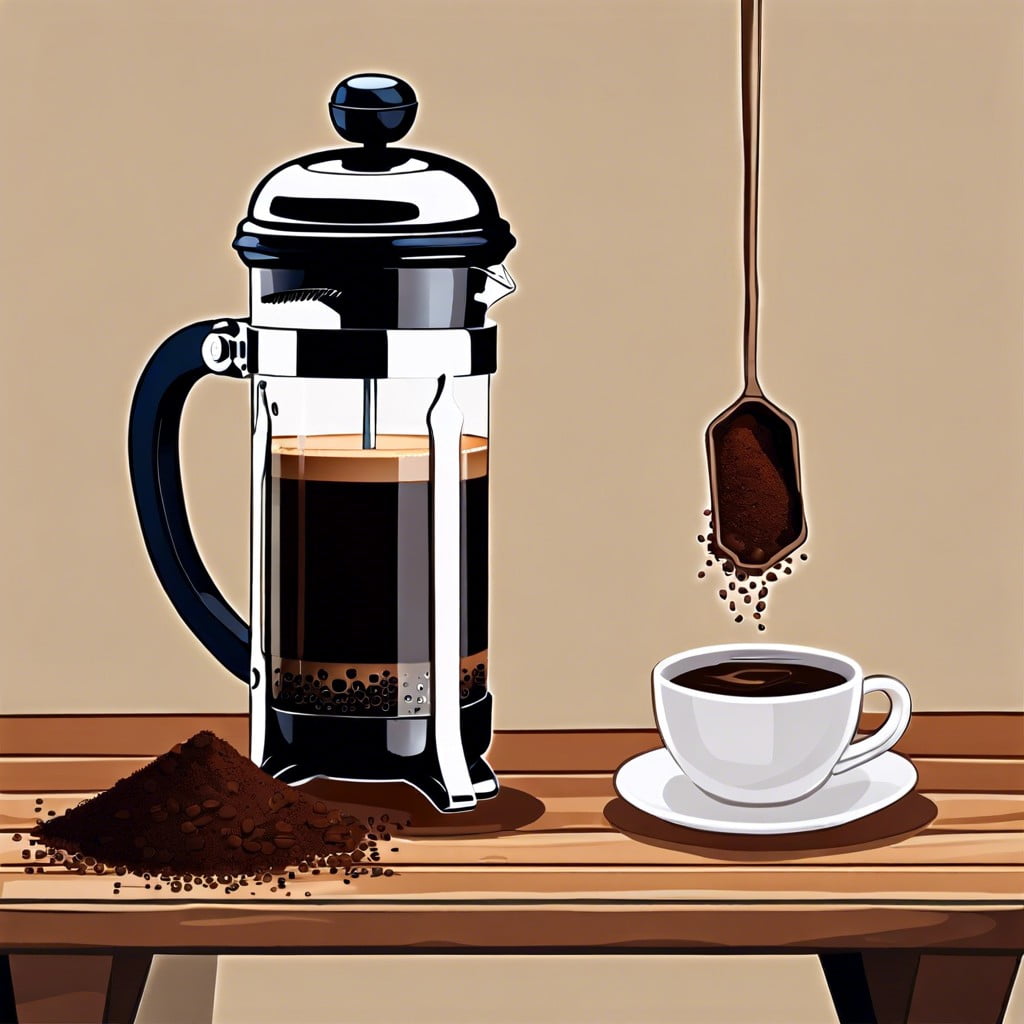Learn how to steep the perfect French press coffee for a rich and full-flavored brew.
How a French Press Works

A French Press, also known as a press pot, capitalizes on simplicity to brew rich, flavorful coffee. Here’s how it works:
- Plunger and Lid: ** A key component, the plunger, is attached to a mesh filter and a lid. When depressed, the plunger pushes the grounds to the bottom, separating them from the liquid.
- Carafe: ** Typically made from glass or stainless steel, this is where you place the coffee grounds and hot water.
- Extraction Process: ** Simply add coarse coffee grounds to the carafe, pour in hot water, and let it steep. Pressing the plunger down after steeping traps the grounds at the bottom, leaving you with a delightful brew above.
The technique requires no electricity, just a bit of arm strength and patience, allowing the flavors and oils of the coffee to meld perfectly with the water. The result is a bold, full-bodied cup that coffee enthusiasts cherish.
Coffee Amount and Grind Size
Achieving the ideal brew starts with nailing the correct coffee amount and grind size. Generally, a ratio of 1:15, which is one part coffee to fifteen parts water, works wonders. This translates to about 30 grams of coffee for 450 ml (about 15 ounces) of water.
Opt for a coarse grind, akin to sea salt. This size ensures the optimum extraction and prevents the common pitfall of a bitter, over-extracted brew that finer grinds might cause. Remember, a French Press thrives with consistency, so ensure your grind is uniform. A burr grinder is best suited for this.
These details make or break the creation of that perfect cup of coffee in a French Press. Adjust the ratios based on your taste preferences and the size of your French Press for best results.
Water Amount and Temperature
A rule of thumb for water-to-coffee ratios in a French Press is 15:1. That means for every gram of coffee, use 15 grams of water. So, if you’re brewing with 30 grams of coffee, aim for 450 grams (or milliliters) of water.
Temperature plays a critical role, too. Ideally, the water should be just off the boil, about 195°F to 205°F (90°C to 96°C). If the water is too hot, it can cause over-extraction, leading to a bitter flavor. Too cool, and under-extraction occurs, making the coffee taste weak.
Precision helps achieve repeatable results. Consider using a kitchen scale and a thermometer to capture the perfect balance each time you brew. This attention to detail can transform your morning cup from ho-hum to a sensory delight.
Step-by-Step: How to Use a French Press for a Perfect Cup of Coffee
Begin by adding your coffee grounds to the clean, dry French press. A good rule of thumb is to use about 1 ounce (28 grams) of coffee for every 4 cups (32 ounces) of water. Adjust based on your taste preferences.
Pour hot water—not quite boiling—into the press, saturating all the grounds as you fill it up to the desired level. The ideal temperature for the water is about 195°F to 205°F (90°C to 96°C). This ensures optimal extraction of the coffee flavors without scalding the beans.
Stir the brew gently with a long spoon to break up the crust of grounds that forms on top. This helps to evenly distribute the grounds in the water and promotes a balanced extraction.
Place the lid on the press with the plunger pulled all the way up. Let the coffee steep for about 4 minutes. This duration strikes a balance between flavor and extraction. If you prefer a stronger cup, you can let it steep for an additional minute or two, but be cautious of over-extraction which can lead to bitterness.
After steeping, steadily press the plunger down. Apply gentle pressure to avoid agitating the grounds too much, which could release bitter flavors. The plunger should feel firm but not too tough to push down.
Once the plunger is all the way down, serve the coffee immediately to prevent it from continuing to sit with the grounds, which can make it bitter over time. Pour and enjoy your perfectly brewed French press coffee.
How to Clean a French Press
Cleaning a French press is simple and essential for maintaining its performance and ensuring your coffee tastes fresh. Start by discarding the used coffee grounds. Tip: Eject them directly into a compost bin if available, as coffee grounds are great for the garden!
Next, dismantle the press. Separate the plunger unit into its components: the plunger, filter, and lid. Wash each part with warm, soapy water. Use a soft brush or sponge to gently scrub the filter mesh to remove coffee oil and residue. Avoid using abrasive materials that could damage the mesh.
Rinse all parts thoroughly with clean water to remove any soap residue. Air dry the components before reassembling the press. This prevents mold growth and ensures no water spots are left on the glass.
For a deeper clean, especially if you notice lingering coffee smells, soak the disassembled parts in a mixture of one part vinegar to three parts water for about 30 minutes. Rinse well after soaking.
By keeping your French press clean, you’ll guarantee the best possible brew every time. Regular maintenance is key to the longevity of your coffee maker.